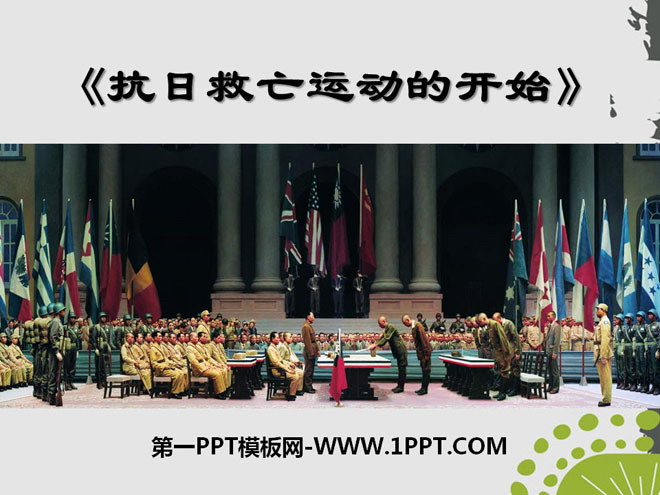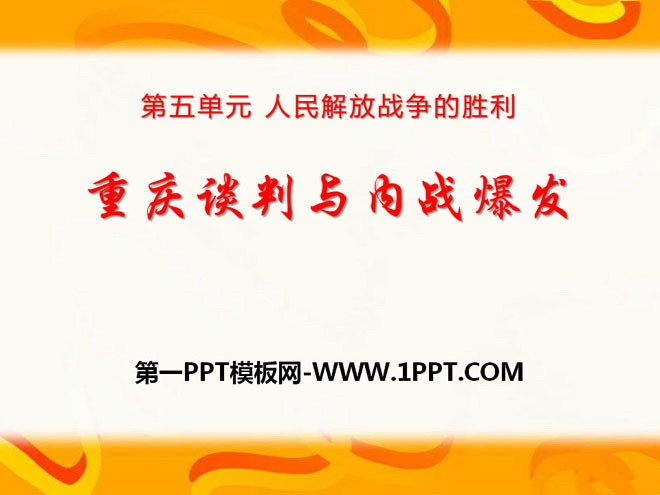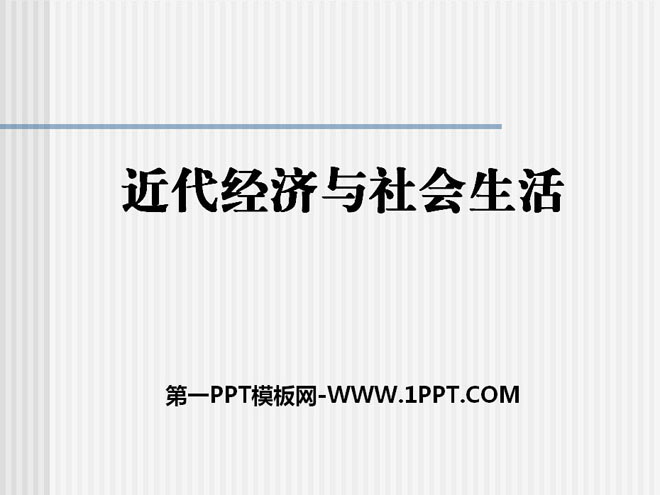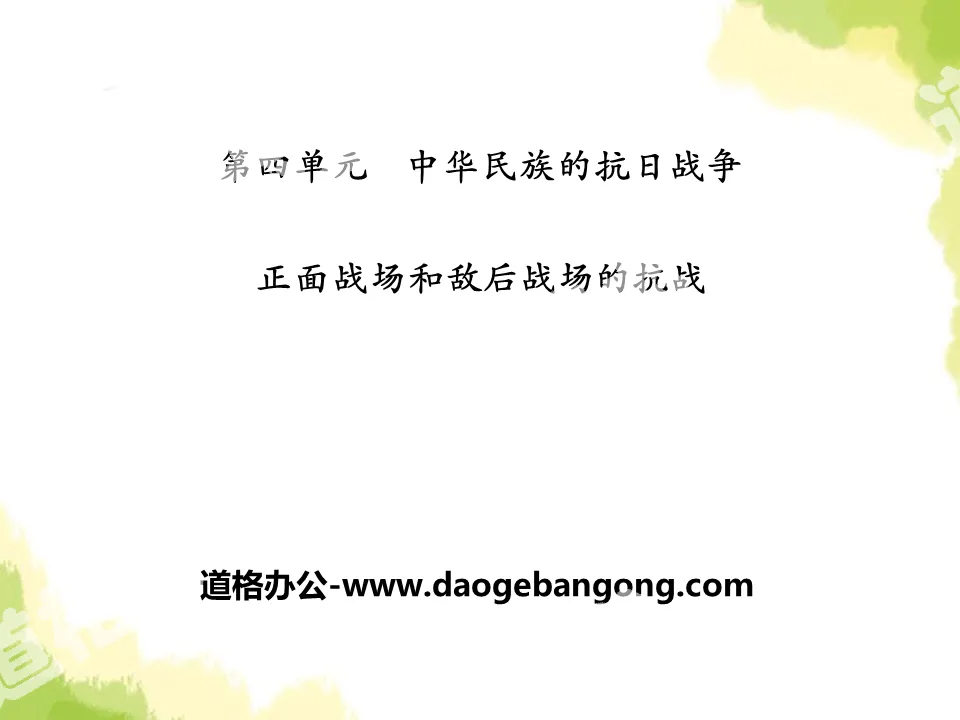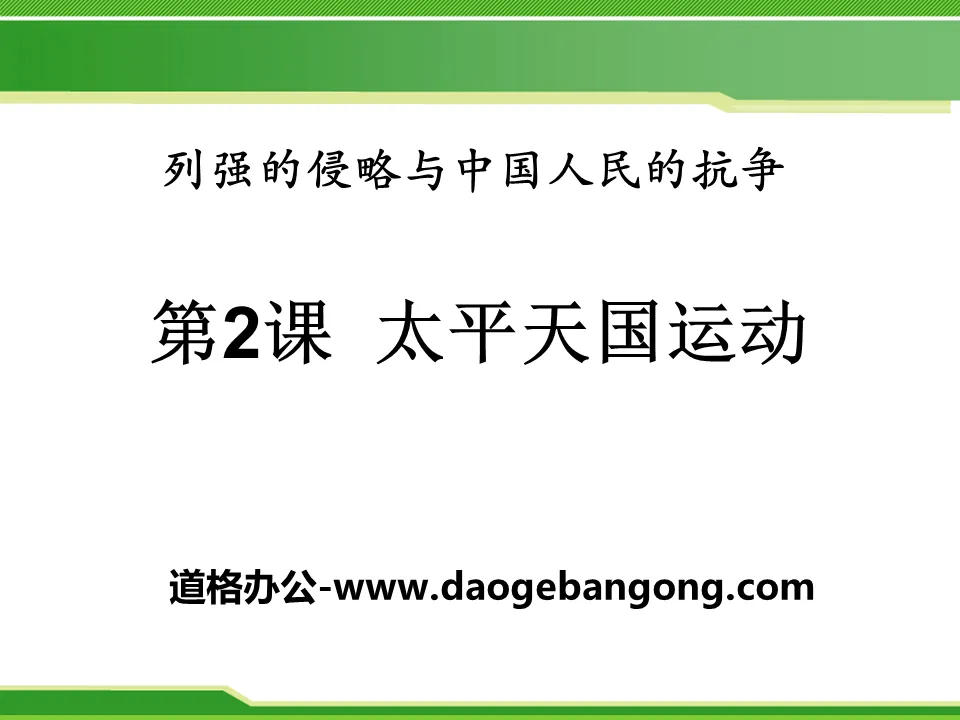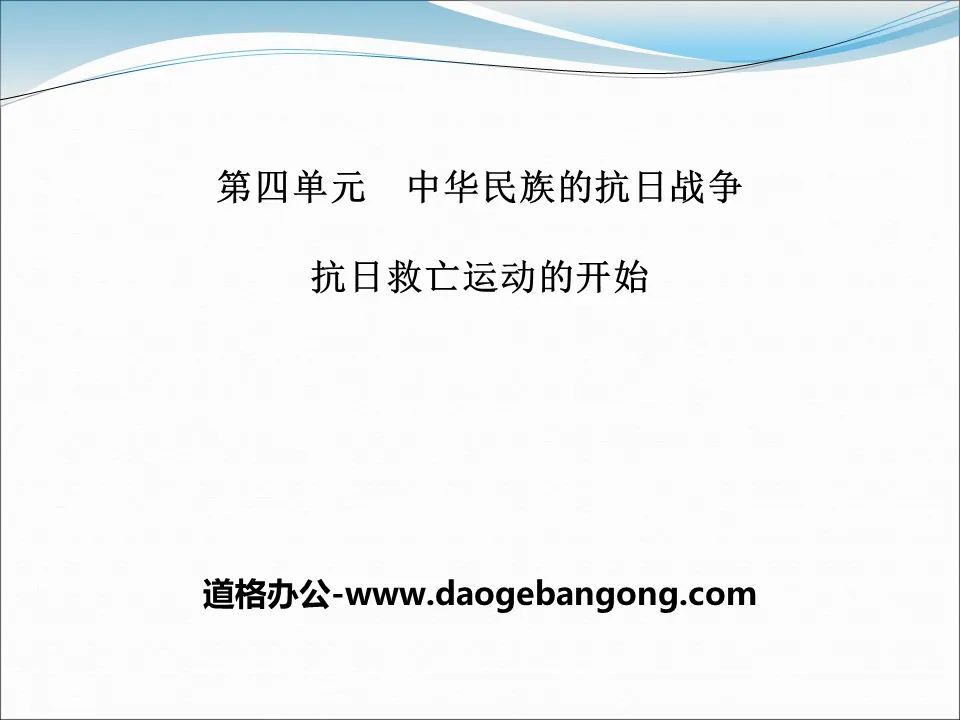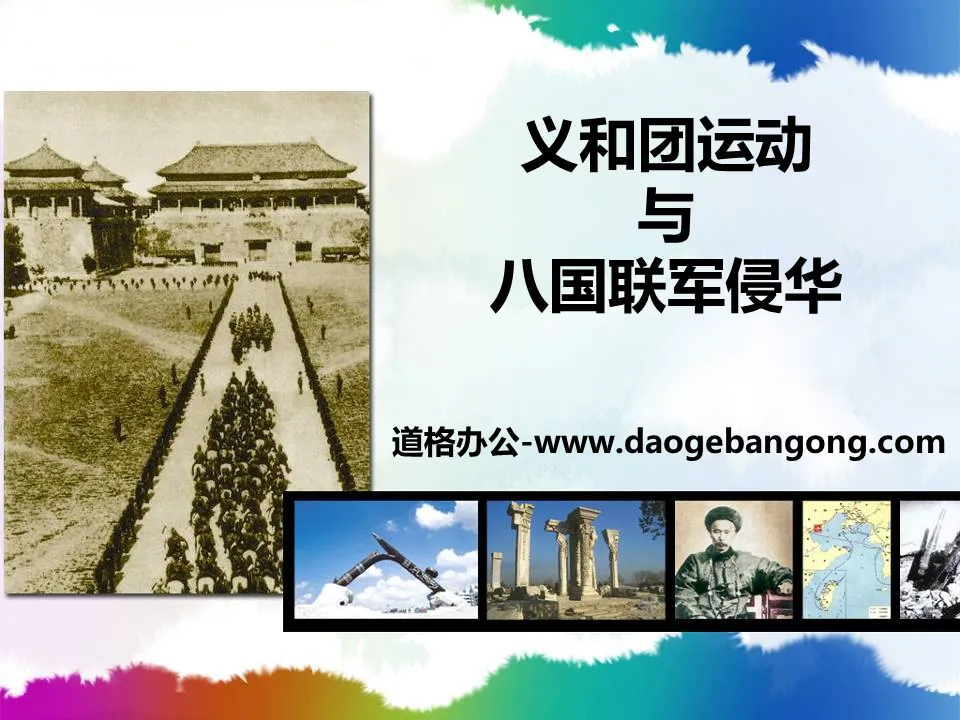
| Category | Format | Size |
|---|---|---|
| Zhonghua Book Company Edition Eighth Grade History Volume 1 | pptx | 6 MB |
Description
"The Boxer Rebellion and the Eight-Power Allied Forces' Invasion of China" The invasion of foreign powers and the resistance of the Chinese people PPT courseware 2
Curriculum Standards
Know the historical facts of the Boxer Rebellion and the fight against the Eight-Power Allied Forces' invasion of China; combine the main contents of the "Xin-Chou Treaty" and analyze the impact of the "Xin-Chou Treaty" on the overall deepening of China's national crisis.
knowledge and abilities
Combined with materials such as "The Boxer Rebellion", we can understand the main characteristics and purpose of the Boxer Rebellion and develop the ability to interpret historical documents.
Understand and analyze the main contents of the "Xinchou Treaty" and understand that the treaty completely plunged China into the abyss of semi-colonial society.
Process and Method
Groups are organized into groups to carry out special research, such as research on the background of the outbreak of the Boxer Rebellion, introduction to the deeds of the Boxer Rebellion and the patriotic Qing army in their fight against the Allied Forces, revelations of the atrocities committed by the Eight-Power Allied Forces during their invasion of China, etc. The results are displayed in class to cultivate independent learning abilities and a sense of cooperation.
Classify and sort out the relevant contents of the Treaty of Nanjing, the Treaty of Shimonoseki and the Treaty of Xinchou, understand the basic clues of China's gradual decline into a semi-colonial and semi-feudal society, and enhance the ability to summarize and compare.
Emotional attitudes and values
Comparatively analyze the Qing government's different attitudes towards the Boxer Rebellion and the Eight-Power Allied Forces' war of aggression against China before and after, understand that the decadent feudal system is the root cause of China's complete transformation into a semi-colonial society, and understand the importance of a strong and advanced leadership group to the rise and fall of the country.
Tell the story of the crimes of the allied forces invading China and the heroic deeds of the Boxer Rebellion and the patriotic Qing army in resisting the allied forces, understand the greed and cruelty of the invaders, feel and learn from the indomitable fighting spirit of the patriotic people and soldiers, and establish a sense of historical responsibility.
focus
1. Understand that the tenacious struggle of the Chinese people is a powerful force that prevents the foreign powers from carving up China.
2. Compare the relevant contents of the "Treaty of Nanjing", "Treaty of Shimonoseki" and "Treaty of Xinchou", and sort out the basic clues of China's gradual decline into a semi-colonial and semi-feudal society.
difficulty
1. Be able to tell the heroic deeds of the Boxer Rebellion people and the patriotic Qing army in fighting against the allied forces invading China.
2. Analyze the main contents of the "Xinchou Treaty" and understand that the signing of the treaty completely turned China into a semi-colonial society.
1. The outbreak of the Boxer Rebellion
background:
1. After the Sino-Japanese War of 1894-1894, Western powers accelerated their efforts to compete for China and set off a frenzy to carve up China. Great powers are scrambling to plunder their rights and interests in China, forcibly rent seaports, and divide "spheres of influence" to carry out economic aggression (external factors). The contradiction between the Chinese nation and Western powers continues to intensify.
"Current Situation Picture" is a cartoon created by Mr. Xie Zuantai in 1898 that reflects the frenzy of the great powers carving up China at that time. In the picture, the bear represents Russia, the tiger represents Britain, the intestine (a snake) represents Germany, the frog represents France, the sun represents Japan, and the eagle represents the United States. The original picture contains a poem by Huang Zunxian, and the original is now stored in the National Archives in Washington, USA.
2. The Qing government imposed excessive levies and increased exorbitant taxes and miscellaneous taxes; disasters occurred frequently in various places, making it difficult for the people to make a living, and class conflicts became acute. (internal cause)
2. Overview of the Boxer Movement:
The Boxers started from Shandong,
In less than March, everything is red.
rise
In the autumn of 1899, the "anti-foreign religion" trend of the Boxer Rebellion, composed mainly of lower-class people, first emerged in Shandong.
Imperialist aggression intensifies and national crisis becomes serious
The power of the church is rampant, leading to people's rebellion
develop
Moved from Shandong to Zhili area (Beijing and Tianjin) in 1900
Yuan Shikai’s bloody suppression
Empress Dowager Cixi (Qing government) changed attitude
climax
In mid-June 1900, he joined forces with the Qing army to fight against the enemy.
The Eight-Power Allied Forces invaded China
The Qing court declared war
result
Beijing fell in August 1900 and the Boxer Rebellion failed.
The joint strangulation of Chinese and foreign reactionary forces
Limitations of the peasant class; lack of scientific theoretical guidance
3. The Eight-Power Allied Forces invaded China
1. background
The imperialist partition aroused the storm of the Chinese people's anti-imperialist struggle.
2. Purpose
Suppress the resistance of the Chinese people and safeguard their interests in China.
3. Time 1900.6
4. composition
British, Russian, German, French, Italian, Austrian, Japanese and American.
5. route
Dagu→Tianjin→Beijing
6. result
On August 14, Beijing fell. Cixi took Guangxu and fled westward in a hurry, and was forced to sign the "Xinchou Treaty"
4. "Treaty of Xinchou"
1. Background: The Qing government surrendered. On the one hand, it worked with the allied forces to suppress the Boxer Rebellion. On the other hand, it negotiated peace with the great powers and signed treaties that were humiliating and humiliating the country.
2. Time: September 1901
3. Signing countries: Russia, Britain, France, Germany, Japan, the United States, Italy, Austria, Belgium, Spain, and the Netherlands.
content
1. The Qing government paid 450 million taels of silver as compensation to various countries, using customs tax revenue as a guarantee, and it was repaid in 39 years, with a total principal and interest of 980 million taels;
2. The Dongjiaomin Lane in Beijing was designated as the embassy boundary, allowing various countries to station troops for protection; Chinese were not allowed to live within the boundary;
3. The Qing government pledged to strictly prohibit the Chinese people from participating in any anti-imperialist activities;
4. The forts fortified along the railway from Dagu, Tianjin to Beijing were all demolished, and the great powers were allowed to station troops at strategic locations along the railway from Beijing to Shanhaiguan.
Influence
1. It increases the burden on the people and further controls China’s economic lifeline;
2. Under the supervision of the embassy district, the Qing government's domestic and foreign affairs were completely under the control of foreigners;
3. The Chinese people were jointly suppressed by Chinese and foreign reactionary forces, and the Qing Dynasty became the court of foreigners;
4. China has lost its military autonomy.
training camp
1. After the "Xinchou Treaty" was signed, Feng, who lived in Dongjiaomin Lane, Beijing, was forced to move with his family. The main reason is ( )
A. Imperialist countries want to open commercial ports here
B. Imperialist countries want to build churches here
C. Imperialist countries want to set up factories here
D. Imperialist countries want to set up embassies here
2. Fighting foreign aggression and defending national sovereignty and national dignity are one of the fine traditions of the Chinese nation. Among the following historical facts that reflect this tradition, which one is incorrect ( )
A. Lin Zexu sold out cigarettes in Humen
B. Zuo Zongtang regained Xinjiang
C. Deng Shichang died heroically for his country
D. The Boxers killed Wall, the leader of the foreign rifle team
3. The minutes of the 299th meeting of the "Tianjin Provisional Government Committee" show that the following amounts paid by the committee to the Public Works Bureau were used to implement this treaty. This treaty is ( )
It costs 10,000 yuan to dismantle the Shanhaiguan fort.
1,000 yuan to dismantle Dagu South Fort
3,000 yuan to dismantle Dagu North Fort
A. "Agreement of Nanjing"
B. Treaty of Tianjin
C. Treaty of Shimonoseki
D. "Treaty of Xinchou"
Keywords: teaching courseware on the aggression of the great powers and the Chinese people’s struggle, teaching courseware on the Boxer Rebellion and the Eight-Power Allied Forces’ invasion of China, download of the history PPT courseware for the first volume of the eighth grade version published by Zhonghua Book Company, download of the history slide courseware for the eighth grade, the aggression of the great powers and the Chinese people’s struggle Download PPT courseware on resistance, download PPT courseware on the Boxer Rebellion and the Eight-Nation Allied Forces’ Invasion of China, in .PPT format;
For more information about the PPT courseware "The Invasion of Great Powers and the Chinese People's Resistance, the Boxer Rebellion and the Eight-Nation Allied Forces' Invasion of China", please click the "The Invasion of the Great Powers and the Chinese People's Struggle ppt Boxer Rebellion and the Eight-Nation Allied Forces' Invasion of China" ppt tag.
"The Boxer Rebellion and the Eight-Power Allied Forces' Invasion of China" The invasion of foreign powers and the resistance of the Chinese people PPT courseware 3:
"The Boxer Rebellion and the Invasion of China by the Eight-Power Allied Forces" The invasion of foreign powers and the resistance of the Chinese people PPT courseware 3 1. The rise and development of the Boxer Rebellion 1. Original name: Boxer 2. Region: Shandong, Henan, Zhili 3. Members: poor farmers Mainly 4. Reason: The Sino-Japanese War of Sino-Japanese War started with...
"The Boxer Rebellion and the Eight-Power Allied Forces' Invasion of China" The invasion of foreign powers and the resistance of the Chinese people PPT courseware:
"The Boxer Rebellion and the Eight-Power Allied Forces' Invasion of China" The aggression of the foreign powers and the resistance of the Chinese people PPT courseware learning objectives: Know the historical facts of the Boxer Rebellion and the fight against the Eight-Power Allied Forces' invasion of China; combine the main contents of the "Xin-Chou Treaty" and analyze the impact of the "Xin-Chou Treaty" China's national crisis...
File Info
Update Time: 2024-07-02
This template belongs to History courseware Zhonghua Book Company Edition Eighth Grade History Volume 1 industry PPT template
"The Boxer Rebellion and the Eight-Power Allied Forces' Invasion of China" The invasion of foreign powers and the resistance of the Chinese people PPT courseware 2 Simple campus recruitment activity planning plan summary enterprise and institution recruitment publicity lecture PPT template is a general PPT template for business post competition provided by the manuscript PPT, simple campus recruitment activity planning plan summary enterprise and institution recruitment promotion Lecture PPT template, you can edit and modify the text and pictures in the source file by downloading the source file. If you want more exquisite business PPT templates, you can come to grid resource. Doug resource PPT, massive PPT template slide material download, we only make high-quality PPT templates!
Tips: If you open the template and feel that it is not suitable for all your needs, you can search for related content "The Boxer Rebellion and the Eight-Power Allied Forces' Invasion of China" The invasion of foreign powers and the resistance of the Chinese people PPT courseware 2 is enough.
How to use the Windows system template
Directly decompress the file and use it with office or wps
How to use the Mac system template
Directly decompress the file and use it Office or wps can be used
Related reading
For more detailed PPT-related tutorials and font tutorials, you can view: Click to see
How to create a high-quality technological sense PPT? 4 ways to share the bottom of the box
Notice
Do not download in WeChat, Zhihu, QQ, built-in browsers, please use mobile browsers to download! If you are a mobile phone user, please download it on your computer!
1. The manuscript PPT is only for study and reference, please delete it 24 hours after downloading.
2. If the resource involves your legitimate rights and interests, delete it immediately.
3. Contact information: service@daogebangong.com
"The Boxer Rebellion and the Eight-Power Allied Forces' Invasion of China" The invasion of foreign powers and the resistance of the Chinese people PPT courseware 2, due to usage restrictions, it is only for personal study and reference use. For commercial use, please go to the relevant official website for authorization.
(Personal non-commercial use refers to the use of this font to complete the display of personal works, including but not limited to the design of personal papers, resumes, etc.)
Preview



